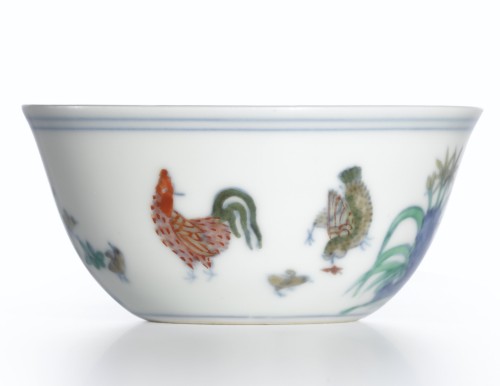
The Meiyintang Chicken Cup. A Doucai 'Chicken Cup' Mark and Period of Chenghua (1465-87). Sold by Sotheby's in 2014 at 281,240,000 HKD.
Literal translation: "colors which fit together" but also 'contrasting' or 'joined colors'. Decoration in a combination of underglaze cobalt blue outlines and enamels added on top of the fired glaze, within the outlines. Invented during the Ming, Xuande period but are mostly associated to the Ming, Chenghua reign (1465-87).
Worth noticing as a personal observation is that in the local Jingdezhen dialect "doucai" just means that the decoration is on both sides of the glaze as in both underglaze and enamels - "both sides".
In this decoration the design is outlined in underglaze blue and filled in with overglaze coloured enamels except blue, since there was no satisfactory overglaze blue enamel at this time. Blue elements of the design were painted under the glaze.
Doucai wares are the best known ceramics produced in the Chenghua period (AD 1465-87). The perfectly crafted cups and dishes were typically small; the emperor Chenghua particularly liked to hold them in his hands. However, their small size was also a matter of technique: if the outline painter made a mistake, it meant disaster, since the cobalt was immediately absorbed into the unglazed body.
Most doucai pieces have a reign mark of four- or six-characters. However, one jar in the British Museum has a single-character mark: tian ('heaven'), probably referring to the emperor. There are similar marks on jars in other museums and on shards that have been excavated recently, but no one yet knows why this mark appears only on this type of jar from the Chenghua period.
The production of imperial porcelain declined drastically after the Chenghua emperor died, inclusive of course doucai wares though small quantities were produced in the sixteenth century. The technique was revived in the eighteenth century, during the Qing dynasty and excellent porcelain of this type was made during the first decades of the 20th century.
Due to the expense and difficulty of production, the use of the doucai technique to decorate porcelains had been largely abandoned after the end of the Chenghua period. Some doucai-decorated porcelains were made in the Jiajing reign, but these often had rather dull greyish body material, pale cobalt, and weakly drawn lines.
It may be noted that both Jiajing and Wanli copies of Chenghua doucai porcelains are frequently larger than the Chenghua originals, although the designs are often copied with considerable accuracy.